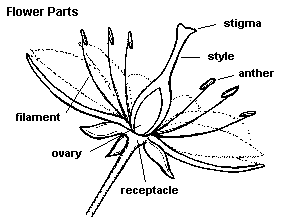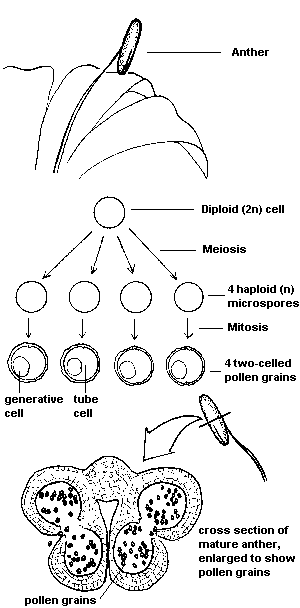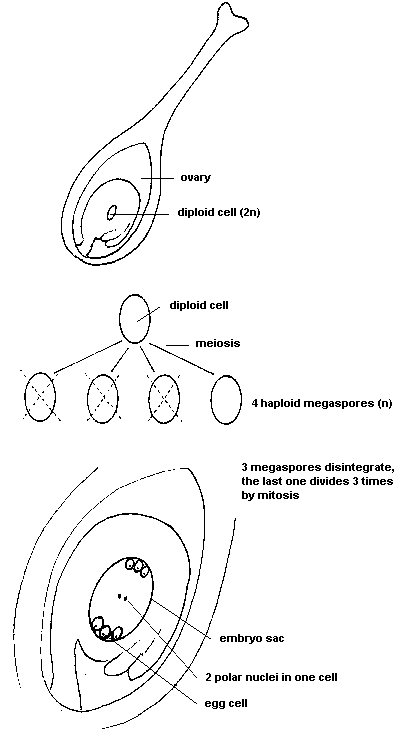Let’s begin with a summary of reproduction in animals.
In animals, meiosis results directly in the formation of gametes—the reproductive
cells, egg and sperm. The successful union of an egg and a sperm is called fertilization, and the resulting cell
is called a zygote. The zygote contains
genetic material donated from both parents, and is genetically distinct from either. In plants, there are some intermediate
steps in the process. Rather than producing egg and sperm, plants use meiosis to produce spores. Let’s take a closer look.

Formation of male gametes. In the anthers
of a flower, certain diploid cells undergo meiosis, forming haploid spores (called microspores—"little
spores"). These microspores divide by mitosis to form two-celled pollen, consisting
of a tube cell and a generative cell.

If the pollen reaches a receptive stigma (female plant
part), the pollen germinates. The generative cell divides by mitosis to form two sperm;
the tube cell elongates to form the pollen tube.

Formation of female gametes. The female
gametes, or eggs, are formed in the ovules, within the flower. Here, as above, a certain
diploid cell undergoes meiosis; however, in this case the result is four haploid megaspores—"large spores").
Three of the megaspores die, and the remaining one undergoes mitosis several times. One of
these daughter cells then functions as an egg, ready to be united with a sperm.


|
|
 A
Perfect Flower.
Can you find a "perfect" flower in your garden?
Do you remember your flower parts from Part I
of this course? Following are some terms you may find in plant-related literature.
In horticultural terms, a perfect
flower contains both stamens and pistils. (Remember that stamen is the male part, pistil
is the female part.)
An imperfect flower is missing one
or the other of these. (For example, a male squash flower is considered imperfect, because
it contains stamens but no pistil.)
A complete flower has all the
"normal" flower parts—stamen, pistil, petals, and sepals. An incomplete
flower lacks one or more of these.
Can you find examples of imperfect, complete,
and incomplete flowers too? |

Flower Gender.
You may know that squash plants produce distinct male and female
flowers—that is, some flowers have only stamens (containing pollen), and some flowers
have only a pistil (containing eggs).
Plants with this characteristic are called monoecious (mon-EE-shus). In most
cases, bees inadvertently transfer pollen from male to female flower in their never-ending
quest for nectar. They get their nectar, and we get our squash flowers pollinated.
But if for some reason the bees aren’t doing the job,
you might need to go out there and do it yourself, using a small artist’s paintbrush
to transfer pollen to the sticky female stigma. Another example of a monoecious plant is
the begonia.
Plants like holly that produce their male and female flowers
on entirely separate plants are termed dioecious
(die-EE-shus). Make sure you have a female plant if you want holly berries, since only the
females produce fruit—and remember that you’ll need a compatible male nearby.
(Reputable nurseries will specify their holly plants’ sex—it’s
impossible to tell by looking at the shrub, unless it already has flowers or berries!) |
|
|
|